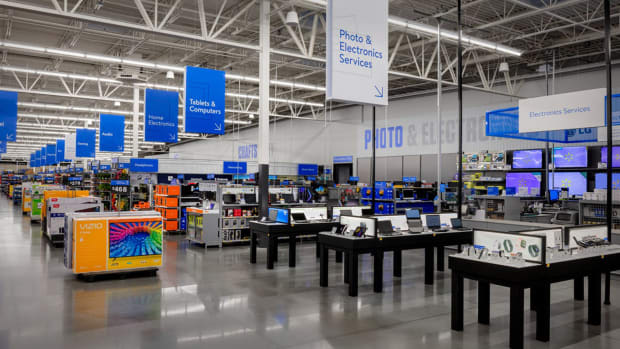
Walmart (WMT) dropped devastating news on a lot of customers April 11 that does not give them much time to act fast.
Walmart's decision to shutter four stores in Chicago generated a lot of attention, but the stores' regular shoppers don't have much time grab those last items in a short timeframe as the stores are set to close for good on April 16.
But here’s the most surprising thing about the move: that Walmart kept those stores open this long.
In a statement, the company said the stores — a supercenter and three smaller Neighborhood Market locations — were losing money. A lot of it.
“Collectively our Chicago stores have not been profitable since we opened the first one nearly 17 years ago,” Walmart said. “These stores lose tens of millions of dollars a year, and their annual losses nearly doubled in just the last five years.”

Walmart
Willing To Tolerate Losses
That’s an extraordinary admission for a couple of reasons. One, retailers jealously guard their individual store data. So obviously Walmart felt it needed to disclose those figures to justify a decision the company knew would attract considerable backlash from city and community leaders.
The second is that Walmart absorbed such staggering losses for nearly two decades. This from a retailer with a reputation for paying workers crap, squeezing vendors for every ounce of profit margin, and threatening to close stores if workers tried to unionize.
So what made these stores so special?
Walmart may be a penny pincher but the world’s largest retailer has demonstrated a tolerance for red ink if there’s a big enough reward at the end of the rainbow.
Hence, Walmart’s expansion into China and Mexico, which cost the company a lot of money. American retailers have fared poorly entering foreign markets (Target couldn’t even hack it in Canada!) and Walmart struggled for many years. Today, Walmart International accounts for 18% of its total revenue of $573 billion. Last year, the unit generated operating income of $3.8 billion.
And though Walmart is strongest in suburbs and rural regions, it made sense to expand into cities and large metropolitan areas because that’s where most people live. Retailers go where people go.
It also helps when city leaders offer you big tax breaks. Brian Kelly, a former Sears executive and retail consultant who lives in the Chicago area, says the city under then Mayor Rahm Emanuel made a big push to attract big brand retailers like Walmart and Target Corporation (TGT) into the area.
Stores' Impact On E-commerce
But tax breaks alone won’t cut it. One important aspect that people have overlooked with Chicago is that stores these days are not just stores.
Physical stores also act as distribution hubs for e-commerce, meaning retailers use the store’s inventory to fill Internet orders, whether delivery or buy online or pick up in store. Thus a store can exponentially project its sales impact far beyond its physical walls.
According to a filing with the Securities and Exchange Commission, Walmart’s e-commerce business contributed 0.7% to its comparable sales growth of 6.4% in 2022 and a whopping 5.4% to its comp sales growth of 8.7% in 2021.
“We continue to focus on a seamless omni-channel experience for our customers,” the company said in the filing.
It’s not clear whether Walmart’s financial disclosures about Chicago reflected online sales. But it’s likely that Walmart was able to keep them open a lot longer because of their role in facilitating e-commerce versus exclusively relying on sales from people who shop the store.
Elephant In The Room
In the end though, a store still needs to perform on its own. And the numbers in Chicago look pretty bad. One piece of crucial information in Walmart’s statement is that the stores’ annual losses doubled over the last 5 years.
What has happened over the past five years? The outbreak of covid and the resulting global pandemic, which scared off people from visiting stores. And then there’s the surge of retail thefts in cities, which have prompted retailers to place shampoo and toothpaste in locked cases and even close stores.
Crime, especially in Chicago, is the elephant in the room, said Carol Spieckerman, president of Spieckerman Retail consulting firm in Bentonville, Arkansas, where Walmart is based. She has no doubt that thefts played a significant role in Walmart’s decision.
Not that Walmart would cop to that explanation. In fact, the company seems to go out of its way to stress that poor financial performance and perhaps bad execution was the reason behind the move.
Anything but crime.
“Over the years, we have tried many different strategies to improve the business performance of these locations, including building smaller stores, localizing product assortment and offering services beyond traditional retail,” the company said. “It was hoped that these investments would help improve our stores’ performance. Unfortunately, these efforts have not materially improved the fundamental business challenges our stores are facing.”
Here’s the coup de grace:
“Community and city leaders have been open and supportive as we met with them over the years to share these challenges,” the company said. “As we looked for solutions, it became even more clear that for these stores, there was nothing leaders could do to help get us to the point where they would be profitable.”
In Chicago, you can’t talk about the city without talking about crime. And you can’t talk about crime without talking about class and race, that these stores were located in poorer Black and Latino communities.
Walmart, however, seems to want no part of that hot potato.







